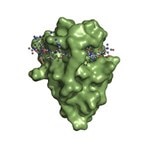Overview of the most recent Spot Peptide-Tag & Spot-Nanobody publications
ChromoTek’s Spot-Tag system for universal capture & detection applications such as immunofluorescence, immunoprecipitation, and protein purification
More and more publications are coming up using ChromoTek’s Spot-Tag system, the first peptide-tag specific Nanobody system for universal capture & detection applications.
 Interaction of Spot-Nanobody (green) with Spot Peptide
Interaction of Spot-Nanobody (green) with Spot Peptide
Here is a selection of the most recent articles using ChromoTek’s Spot-Tag and accompanying products:
Caspase cleavage releases a nuclear protein fragment that stimulates phospholipid scrambling at the plasma membrane
Masahiro Maruoka, Panpan Zhang, Hiromi Mori, Eiichi Imanishi, Daniel M. Packwood, Hiroshi Harada, Hidetaka Kosako, and Jun Suzuki
Maruoka et al. investigated the activation of plasma membrane scramblase Xkr4. They screened a cDNA library for a constitutively active form of Xkr4 and identified XRCC4 as an activator. The activation is mediated through a caspase cleaved fragment of XRCC4, which is released into the cytoplasm and binds to Xkr4.
ChromoTek’s Spot-Trap was used to immunoprecipitate “membrane fractions of XRCC4 KO PLB cells expressing SPOT-Xkr4DC-FLAG … with anti-SPOT nanobody-conjugated beads to precipitate Xkr4 interactors, followed by mass spectrometry.” The anti-SPOT nanobody-conjugated beads used were our Spot-Trap Magnetic Agarose (etma-10).
Mol Cell 2021. S1097-2765(21), 00135-0. https://www.sciencedirect.com/science/article/abs/pii/S1097276521001350
The Phosphoarginine Phosphatase PtpB from Staphylococcus aureus Is Involved in Bacterial Stress Adaptation during Infection
Mohamed Ibrahem Elhawy, Sylvaine Huc-Brandt, Linda Pätzold, Laila Gannoun-Zaki, Ahmed Mohamed Mostafa Abdrabou, Markus Bischoff, and Virginie Molle
Elhawy et al. investigated the role of PtpB for infection with Staphylococcus aureus. PtpB is a low-molecular-weight phosphatase. S. aureus strains with deleted ptpB result in reduced amounts of bacteria in tissue sections. In addition, their results suggest “that PtpB affects the transcription of various genes involved in oxidative stress adaptation and infectivity.”
ChromoTek’s pSpot2 vector was used as a template for amplifying the Spot sequence and to generate pRMC2_PtpA-Spot, pRMC2_PtpB-Spot, and pRMC2_SecA-Spot VIA Gibson assembly. Obtained supernatants corresponding to macrophage lysates were immunoprecipitated with Spot-Trap Magnetic Agarose, with detection in Western blot on PVDF membranes using Spot VHH in combination with an HRP-coupled goat-anti-lama antibody as a secondary antibody (Bethyl).
Cells 2021. 10(3), 645. https://www.mdpi.com/2073-4409/10/3/645/htm
Destabilization of the holo-DNA Polδ by loss of Pol32 confers conditional lethality that can be suppressed by stabilizing Pol31-Pol3 interaction
Kenji Shimada, Monika Tsai-Pflugfelder, Niloofar Davoodi Vijeh Motlagh, Neda Delgoshaie, Jeannette Fuchs, and Susan M. Gasser
DNA Polymerase δ is essential for genome replication and the preservation of genome integrity. In S. cerevisiae, Polδ consists of 3 subunits: the catalytic subunit Pol3 and the regulatory subunits Pol31 and Pol32. The roles of subunits Pol31 and Pol32 are still unclear. In this study, Shimada et al. characterized the functions of subunit Pol31 under DNA damage stress and in compensating for the loss of subunit Pol32. Both Pol31 and Pol32 are of interest for cancer research, as the human counterparts POLD2 and POLD3 are commonly found to be amplified in tumors.
To investigate the levels of Pol3 and the effect of Pol31 and Pol32 and variants thereof, Spot-Tag was introduced at the N-terminus of Pol3. N-terminal Spot-Tag ensured minimal disruption of the DNA Polymerase δ complex while C-terminal Myc-tagging of Pol3 had shown to be lethal. Subsequently, Spot-Trap Magnetic Agarose was used to co-immunoprecipitate Pol3 and the residual subunits Pol31 and Pol32 as well as subunit variants.
bioRxives February 2021. https://www.biorxiv.org/content/10.1101/2021.02.11.430699v1
Protein Detection and Localization in Plant Cells Using Spot-Tagging
Andriani Mentzelopoulou, Chen Liu, and Panagiotis Nikolaou Moschou
Fluorescent labeling of proteins while maintaining the protein’s activity, localization, and function is a major challenge. Mentzelopoulou et al. introduced the Spot-Tag in combination with Spot-Label as a labeling strategy for proteins in high-resolution imaging of plant cells, using the microtubule motor centromeric protein E-related Kinesin 7.3 as an example. Using the Spot system the authors achieved protein labeling with minimal linkage errors in fixed and living cells. In addition, “Spot-tagging did not interfere with microtubules and spot staining resulted in a close-grained fluorophore labelling revealing a localization pattern that resembles ‘beads-on-a-string.’” Mentzelopoulou et al. anticipate that their protocol “will apply to many more demanding protein cellular targets, offsetting activity perturbations and low photon quantum yields imposed by other protein-tagging approaches.”
bioRxives November 2020. https://www.biorxiv.org/content/10.1101/2020.11.24.396507v1
Molecular height measurement by cell surface optical profilometry (CSOP)
Sungmin Son, Sho C. Takatori, Brian Belardi, Marija Podolski, Matthew H. Bakalar, and Daniel A. Fletcher
In this article, Son et al. used single-molecule localization in one dimension to quantify the average height of multidomain proteins, detect changes in height due to crowding, and report average protein and glycan heights on native cell surfaces. They used a new method that they call cell surface optical profilometry (CSOP), which provides ∼1-nm resolution.
Different recombinant proteins were expressed with an N-terminal Spot-Tag and the proteins were integrated in Giant Plasma Membrane Vesicles. Spot-tagged proteins were imaged using Spot-Label, which introduced an offset of less than 1 nm. Using Spot-Tag and Spot-Label, Son et al. found that “The high labeling ratio combined with the lack of the labeling site specificity allows us to assume the center of mass of the molecule as its location.”
PNAS 2020. 117(25), 14209-14219. https://www.pnas.org/content/117/25/14209.long
Applications for Spot-tag
- Immunoprecipitation (IP) / Co-IP: Spot-Trap
- Co-IP/MS: Spot-Trap and iST Spot-Trap Kit
- Protein purification: Spot-Cap
- Immunofluorescence: Spot-Label
- Western Blotting: Spot-tag® antibody (28A5)